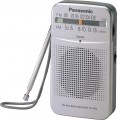Tuner type
A type of tuner used in radio receivers.
-
Analogue. Tuning to the desired frequency in such tuners is carried out using the wheel. This scheme is considered more convenient than digital trim (see below), but the accuracy of analogue regulators is lower. This can make it difficult to use the receiver with numerous stations in a small frequency range (especially for FM broadcasts in large cities). In addition, the analogue tuner "does not know how" to memorize stations.
-
Digital. The direct tuning of the tuner in such receivers is performed by an electronic circuit; the user only sets the desired frequency using the increase / decrease buttons or, in advanced models, from the numeric keypad. These tuners are somewhat less convenient for manual tuning, but they do a good job of fine tuning. Also, many receivers with digital tuners have the function of storing stations (see "Station Memory"), automatically searching for all available stations, etc.
Power source
Power supply methods provided in the design of radio receivers and table clocks.
-
Batteries. Powered by standard replaceable batteries (
AA,
AAA,
type C,
LR44,
PP3, etc.). There are two main advantages to this diet. Firstly, a shrunken element can be quickly replaced; for this, of course, you need to have fresh batteries in stock, but it’s easy to take care of this in advance. Secondly, consumer devices are independent of outlets; this allows you to install them on almost any suitable surface, easily move from place to place, without worrying about the length and placement of the mains cable. Batteries, of course, need to be purchased separately, which slightly increases spending. However, many replacement batteries are also available as rechargeable batteries. Thanks to all this, battery-powered models are very popular today.
-
Network. Powered by a standard 230 V network. On the one hand, this option eliminates the hassle of batteries, and on the other hand, connecting to the network is associated with a number of inconveniences: the power cord limits the ability to install a radio or clock in places where there are sockets nearby, moreover the device may interfere or simply not fit into the overall environment. Mai
...ns power in watches is quite rare in its pure form - much more often it is used as a fallback option for battery-powered models: if the situation allows, you can plug the watch into an outlet and not waste the charge.
- Battery. Powered by an original battery that is not related to standard sizes. Like the batteries described above, this option provides the device with autonomy. However, the key difference is that the battery, as a rule, does not provide for quick replacement: a non-standard format makes it difficult to purchase a spare battery, and more often than not, it is generally made non-removable. Therefore, the main, if not the only, option for discharging is charging, which requires a connection to the network and takes quite a long time. As a result, rechargeable batteries are considered a less suitable power option than replacement batteries and are rarely used.Material
The most popular material option for housings today is
plastic. At a low cost, it is quite strong and reliable, can have any colour and a very complex shape, which allows you to create devices with a variety of designs. Therefore, this material is used in all price categories of table clocks.
In addition, there are other options; they, usually, indicate that the watch is created with an emphasis not only on functionality, but also on an attractive appearance. For example, upscale models with pointer dials often use
wood to emphasize the traditional design.
Metal(mainly steel) can be found both in classic and original designs (
watches in glass). And in the most expensive, "image" devices, the main value of which is precisely the appearance, bronze, brass, gilding, marble and other similar premium materials are also used.

